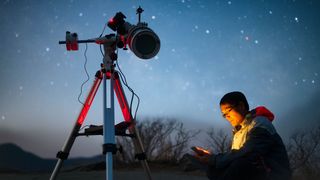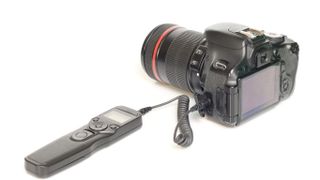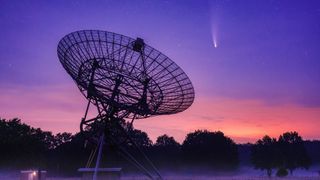Comets are notoriously fickle things. Some are given high expectations of putting on a good show and fail to deliver. In contrast, others, originally thought to be unremarkable, may suddenly flare up to glow at a magnitude that’s visible to the unaided eye. In general, it’s quite difficult to say just how a comet will behave.
In this guide, we’ll be highlighting the latest naked eye comet passing by Earth and give you plenty of tips on how to observe and photograph this and many other types of comets. We’ll be covering the best viewing locations, exploring ideal viewing situations and making concrete suggestions to specific telescopes and binoculars that will aid skywatchers as they observe the comet, as well as outlining the history of each comet and where it’s come from.
Below we’ve also laid out a fool-proof guide on how to photograph a comet with tips on which camera, lens and photography accessories to choose from, with additional advice on composition, camera settings and other techniques required to photograph comets.
How to view the latest comet: C/2022 E3 (ZTF)
- Look to the northeastern horizon between 10pm-12am in Jan 2023
- Comet C/2022 E3 (ZTF) will rise higher until dawn for better observing throughout the month
- Use the Pole Star (Polaris) as a guide to find the comet
The question is, can you see comet C/2022 E3 (ZTF) with the naked eye? By perigee (the point in an orbit at which it is closest to Earth) it is hoped that C/2022 E3 (ZTF) will be brighter than magnitude +6.0, making it visible to the naked eye, at least from very dark sites. As previously mentioned, how much brighter than magnitude +6.0 will remain unknown — comets can be notoriously unpredictable.
In mid-January, the comet rises in the northeast around midnight local time and is best viewed higher in the sky before dawn, while it is still dark. As the month progresses, C/2022 E3 (ZTF) rises earlier and earlier — at perigee, your best bet is to look for it around 10 pm local time. The Pole Star, Polaris, will be a good guide, since the comet is 11.5 degrees to the northeast of it on 31 January.
Telescopes and binoculars to view comets
Currently, C/2022 E3 (ZTF) is just above magnitude +7.0. This means it is too faint to be seen with the unaided eye; you’ll need 7×50 or 10×50 binoculars for comfortable viewing or a small telescope, around 4-inches (100mm) in aperture in order to spot it as a greenish, fuzzy smudge of light. You can check out our best telescopes or best binoculars guides for some great models to suit a variety of budgets. Although sometimes comets have long tails, C/2022 E3 (ZTF) doesn’t have a very long tail, at least not yet.
If the comet does brighten near perigee, as is hoped, it could reach magnitude +5.0. Technically this is within visibility of the unaided human eye, but it is still very faint — if you live near a town with light pollution, you probably won’t be able to see the comet, so it is recommended that you head to a dark site out of your town to have the best chance of seeing it. Of course, it might not get this bright, or it might have an outburst and be even brighter than expected. We’ll just have to wait and see.
Since the naked-eye view is unlikely to wow you, then for the best scenes, imaging is the way to go. However, to get a good image you’ll need some very particular instruments.
Camera equipment needed to photograph a comet
There are two main ways to photograph comets successfully: with a DSLR or mirrorless camera, a camera lens and a tripod; or a camera/smartphone hooked up to a telescope.
The best camera to photograph a comet is, unsurprisingly, one of the best cameras for astrophotography. This calls for good sensitivity to light by utilizing a high ISO range, the ability to keep noise to a minimum and a large image sensor (ideally 35mm full-frame or larger) for lower image noise and a propensity toward a wider dynamic range. See our two top suggestions below, and take a look at our best cameras for astrophotography guide if you want to shop around.
There are several types of camera lenses that are suitable for comet photography, and which one you end up using depends mostly on the brand of your camera system. However, on the whole you want to look for a lens that has a fast maximum aperture (f/2.8 or narrower) and has minimal chromatic aberration (color fringing) and optical distortion. See two suggestions below that sit in our best lenses for astrophotography and best zoom lenses guides.
But for the best images, you’ll need either a DSLR/mirrorless camera or a dedicated CCD or CMOS camera attached to a long-focal-length telescope, all on a sturdy mount that isn’t going to shake and is controlled by a laptop or tablet.
For comet photography through a telescope, we would recommend at least 4-inches (100mm) aperture, a 1.25-inch eyepiece kit (as they fit the majority of telescopes) or binoculars that have large objective lenses with good magnification like 7×50 up to 20×80. See below for our specific recommendations on the latest and best telescopes, binoculars and accessories that will help you view comets.
Camera accessories for photographing comets
There is a bagful of camera accessories astrophotographers can buy that will make comet photography easier. However, the key items to get in order to take better, more accurate astrophotos of comets are as follows.
Tripods and tripod heads
A good tripod is one that will keep the camera and lens stable even during strong winds. Long exposures are required when photographing comets because they are normally best viewed at night because they are quite dim. If the camera moves during exposure then the entire photograph will become blurred, so one of the best tripods for astrophotography will keep the camera stationary when shooting. Pay attention to the maximum payload of each tripod though, the max payload can be calculated by adding the weight of your camera (with memory cards and battery inserted) and your lens, plus any accessories like lens warmers or star trackers. If the weight of all the gear you’ll be using exceeds the tripod’s maximum payload the tripod may be unstable and it is unlikely you will get sharp photographs of comets.
Star trackers
Star trackers are mounts that move with earth’s rotation in order to allow longer exposures (or multiple long exposures over several minutes or hours) of celestial objects. While they are designed for tracking stars they may be helpful in keeping the frame steady when shooting comets, especially on long focal length telephoto lenses.
Remote shutter releases
It’s important not to knock the camera or lens during long exposures so as to avoid camera shake blur. That’s why a remote shutter release should be used when photographing comets and all astrophotography subjects. They come in a variety of shapes and sizes, with wires that attach to proprietary ports on cameras but also in wireless models. We would recommend wireless models on the whole because it avoids the inevitable tangling on wires when shooting, but wired options are usually less expensive.
Camera lens filters
There aren’t many filters that are useful for comet photography. Neutral density filters make the scene darker so would actually hinder rather than help, and graduated neutral density filters are usually used to darken a bright sky which isn’t a problem at night.
However, light pollution filters may prove beneficial to those that are forced to shoot comets near towns and cities with street lighting. The best light pollution filters help alleviate the orange glow found in astrophotos taken near light-polluted areas. Many photographers prefer to edit light pollution out in post-processing software such as Adobe Lightroom or Adobe Photoshop, but for those that want a running start or who prefer to avoid image editing altogether, light pollution filters are a safe bet.
Locations and times to view/photograph comets
Shooting locations vary wildly and depend on the trajectory of a comet as it travels through space and past earth. Keep an eye at the top of this page, and on our other news stories to see where the latest comet is visible in skies near you. There are, however, some key tips on the best comet shooting locations.
The best location for photographing a comet is one that is dark and free from light pollution. Avoid cities and busy towns that have a lot of street lighting as light pollution will glow in the night sky. Instead, use a website like Dark Site Finder to find dark sky locations nearby and schedule a visit.
Cloudless nights are best so use a weather app or check the local forecast before heading out. In the northern hemisphere, the winter months give longer nights which offers greater opportunity for shooting comets and astrophotographs but this often comes with colder temperatures and inclement weather so dress appropriately.
Capturing the comet hanging in the sky on its own is fine for recording purposes, but to make a truly captivating image it may be worth pre-planning a shoot in order to include interesting foreground features. A simple landscape in the foreground adds context but seeking out local landmarks and interesting land features will help push your comet photographs to the next level. Waterfalls, ruins, rock formations or even distant tall buildings (provided there isn’t too much light pollution) can all improve a comet photograph.
Comet viewing opportunities you missed
Comet C/2021 A1 — a.k.a. Comet Leonard (opens in new tab) — is on a last dash through our solar system before disappearing a little later in 2022. The comet has been a dazzling sight in binoculars or telescopes, appearing with a twisted tail and if you have a great camera, a green coma.











